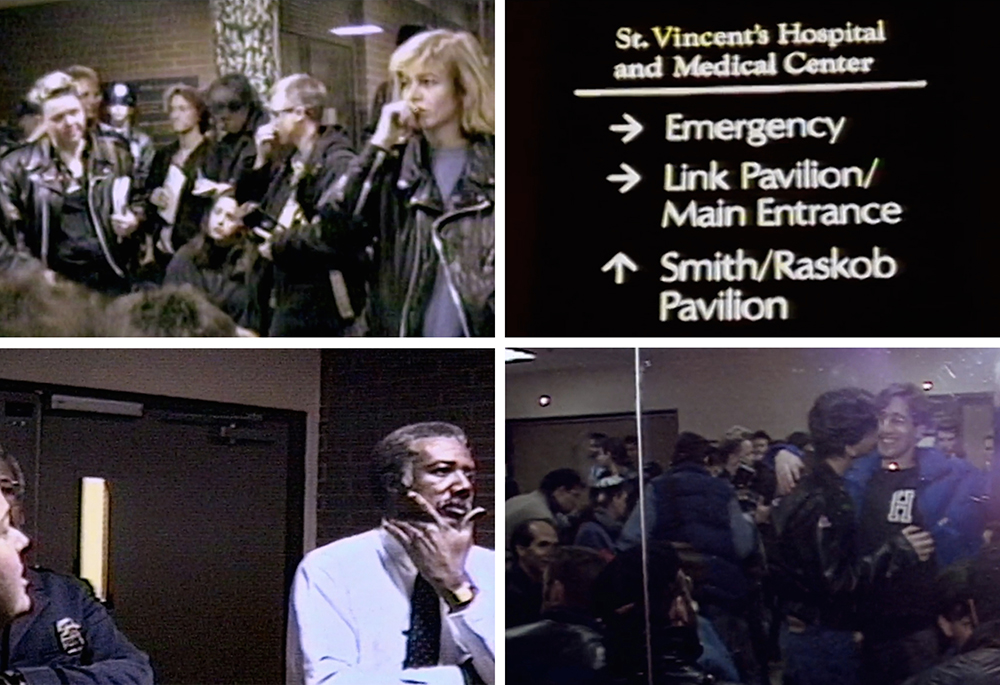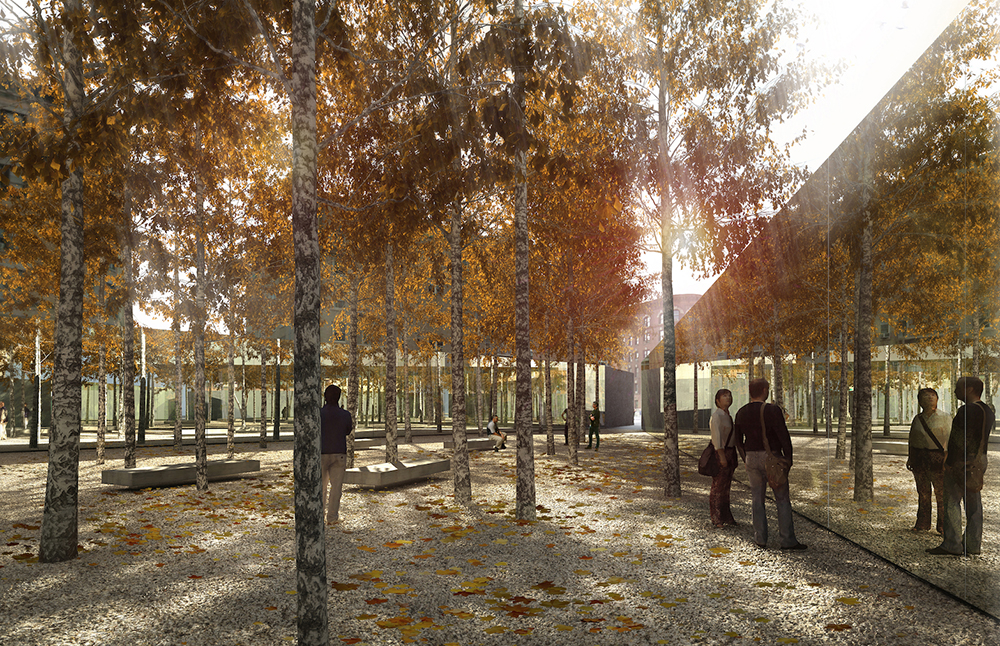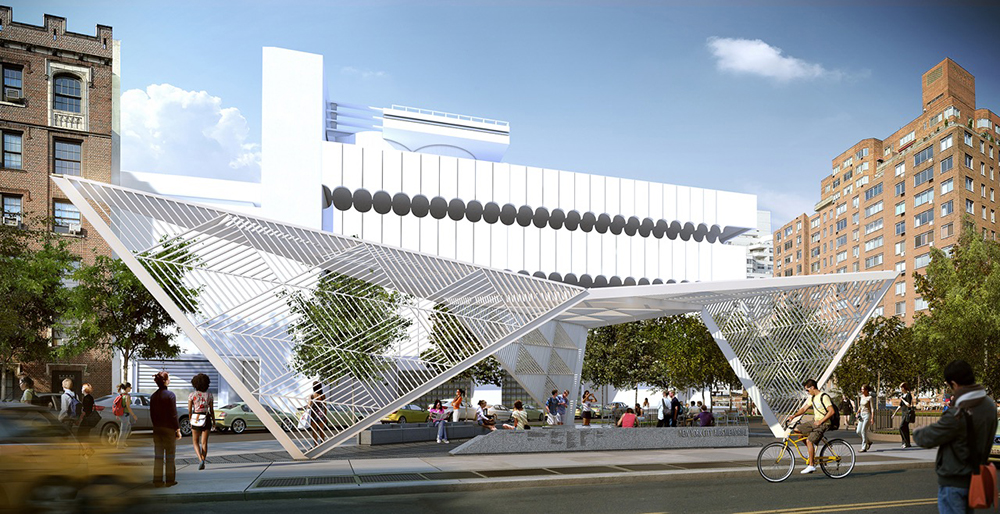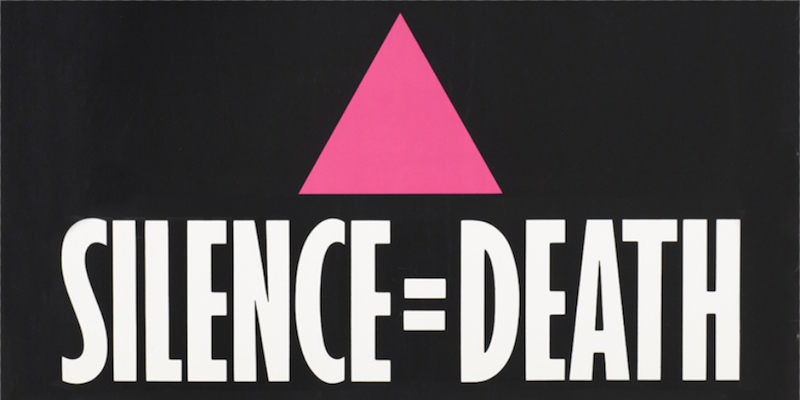I was out on a date some weeknight in the fall of 2011 when conversation turned to architecture and politics. I’d attended a few early meetings about the possible building of a memorial to the victims of AIDS in New York City, and my dinner companion didn’t find it cute. Having assumed the general idea unassailable in such a context, I was taken aback by his assertion that not only was the campaign a misallocation of precious human and material resources during a real and ongoing crisis, but also that it buttressed the conservative cause to assert queer rights via their assimilation into decidedly non-queer spaces.1 My admittedly undercooked defense—that the memorial would serve a valuable educational and not simply symbolic function—didn’t impress. No second date followed.
Four years later, the New York City AIDS Memorial is under construction in the West Village, slated to open in the late spring of 2016. As I mentioned on my date, I was aware of the project after having been introduced to the endeavor’s co-founders, Paul Kelterborn and Christopher Tepper, some years earlier.2 In the project’s early stages during the summer of 2011, I attended meetings of Community Board 2 to show support and to try to discern what form the idea might be able to take, if any. In these meetings, my first enduring and galvanizing reaction was simply surprise: Why didn’t a memorial of significant scale and visibility yet exist in New York?3 To date, more than 100,000 people have died from AIDS-related causes in this state. Adding in the more than 600,000 victims nationally, and the staggering 30 million worldwide, a prominent, if not monumental, memorial could be justified on the basis of numbers alone.4
My second surprise, to the credit of the then-burgeoning organization’s work to-date, was just how perfect a site this was for the memorial’s placement. The proposed location between West 12th Street, Greenwich Avenue, and Seventh Avenue was one of few even remotely underused spaces in the West Village—arguably the epicenter of the New York City AIDS Crisis in the 1980s to early 1990s—and it was already under redevelopment and therefore ripe for design intervention. After St. Vincent’s hospital was shuttered in 2010 (in the face of considerable community resistance), the Rudin Management Company acquired the entire site, which included the so-called triangle park. The AIDS Memorial coalition intervened just as the rezoning process required to convert the former offices, clinics, and hospital rooms into a complex of luxury condominiums designed by FXFOWLE was getting under way.5 Further, and more importantly, the fact that St. Vincent’s housed the first and largest AIDS ward on the East Coast freighted the site with the kind of material history that designers dream of working with and that future generations of visitors, unfamiliar with the crisis’s early days, might learn from.


However, campaigns such as these require more than immediacy to find traction. So, with the successful, if problematic, example of the High Line in full swing just blocks away, the AIDS Memorial team organized an international design competition to lend their argument (at a minimum) some convincing imagery and (at best) inspiring concepts.6 After all, as my date would insist some months later, architecture isn’t the only, or even the obvious response to crises such as this. Making material the fraught discussions taking place carried innumerable risks, not the least of which would be misrepresenting the stakes and further marginalizing those affected by the virus and its associated stigmas.
Ultimately, the jury’s choice of the “Infinite Forest” scheme by New York–based Studio a+i signaled a strategic interest in delivering visibility over all else. Wide, palatable circulation was a requirement if the competition’s organizers actually wanted to build enough interest to get the project off the ground. Given that the rezoning process was already under way, it was also important to immediately help the interested publics imagine a project that was both convincingly necessary in its educational or symbolic value, and convincingly possible in the face of myriad security-, environmental-, and preservation-related concerns that had been expressed by various communities of stakeholders. The admittedly captivating rendering, showing a serene, sunlit space for reflection amid the desperation of the crisis, protected on all sides by a mirrored enclosure, nevertheless struck me as disengaged from the city and therefore from the politics and people walking by on the other side of the walls. I had hoped for a design that would promise to evoke at least some of the anger, impatience, disillusionment, or empathy that I had personally discovered through my involvement. It seemed as though, in addition to honoring the countless people who’d been affected by the virus in years past, this was a unique opportunity to expose the systematic brutality imposed by a system still intent on silencing marginalized voices, and perhaps even help galvanize a concerted resistance.7 For me the peace of an infinite forest sent all the wrong signals.

Disenchanted, I continued following the project from a distance for the next two years as it waded through the morass of landmarks, planning, and development reviews, and as the appointed architects guided the design toward its even more subdued current form, now only occupying a portion of the original site. Educational spaces were removed, vegetation stripped, and gestures muted. If one of the ways that good architecture contributes to difficult discussions is with interventions that don’t reduce but rather illustrate the complexity at hand, by the spring of 2014 I was losing faith that what would soon be found on Greenwich and 12th would qualify. Canopies, poetry, and water features, in this case, do not great architecture make. Worse than the typical complaint of design by committee, I increasingly had the sense that the final design was counterproductive precisely for the reasons discussed two years prior on my date—namely, that it’s much easier to talk about something difficult when difficulty isn’t produced as a result.8



Then, in the summer of 2014, my relationship to the memorial changed yet again when I was diagnosed as HIV positive. In one instant, all the work I had undertaken over a decade to understand my identity and sexuality on affirmative terms seemed to evaporate into thin air. In spite of years of education and positive reinforcement, I felt deeply, blindingly ashamed. Traveling at the time, the New York City I returned to as an HIV-positive man seemed different from the one I had left. As the drama of diagnosis faded, doctors visits became commonplace, and disclosure practiced, I was forced to contend with the more arduous task of mulling over many questions I had thought long-ago answered. And the city-stage for such considerations felt less than accommodating. If they somehow hadn’t before, the worries of the would-be memorial’s elderly neighbors about buses full of gay tourists, the angry community members demanding that the return of a hospital to the site was the only acceptable use of the space, and the hard-nosed negotiations of the Rudin family to retain full and conventional control of their privately owned public space, felt rather personal. How could I engage with the memorial under these newly difficult conditions? What might the rules of something like “critical distance” allow or disallow for my experience of the project as a New Yorker, a critic, and a person with HIV?
Writing about the crisis of affordable housing rings true for authors and readers alike because we are all implicated. Ruminations over the stakes of new cultural monuments are anxious precisely because it’s our society’s supposed values that are being expressed. Climate change isn’t simply an abstract problem much bigger than existing frames allow us to grasp; it’s our future that’s at stake. In her 2013 book Hold It Against Me, when discussing the challenge of writing on art that’s not only “about” emotional topics but actually produces emotional responses, Jennifer Doyle notes that “attention to a work’s controversy actually suppresses attention to a work’s difficulty.”9 In these terms, for me the New York City AIDS Memorial was newly difficult as an object deserving critical attention. The controversy of its design, which I had been following for years and seemed somewhat predictable in retrospect, was now secondary to the much more productive difficulty of its existence in the first place.
Though tempting, it should be possible to utter these statements without falling back onto outmoded reductions reminiscent of another era of identity politics. While skyrocketing rates of inequality are precipitating a revisiting of 1930s-era liberalism, we must also remember the lessons of the 1960s.10 Yes, I identify as a gay man. But this is a shifting identity, whose particularities not only align me with larger common causes but also encourage endlessly isolating—and destabilizing—introspection. Yes, the personal is the political; but the personal isn’t fixed and the political isn’t straightforward. Artists and activists know this to be true and have grappled with the challenge of articulating the codependent and often contradictory definitions of self and society for decades. Designers of the built environment and participants in its discourse, however, have struggled to do the same.11 This in spite of the fact that surely, if there’s anything that makes material Judith Butler’s assertion that “when I say ‘I,’ I mean you, too,” it’s architecture.12
Or, rather, architecture and Instagram. As we follow and are followed, in addition to providing fodder for advertisers, we are also embarking on a transactional project of self-identification en masse. It’s not only what we post but also what we like that form the feedback loops defining our increasingly close relationships with dispersed networks and back again with our digitally mediated selves. I like you, you like me; the images bleed together. Unfortunately, as has been the case with queer critique from within, at the exclusion of what might be more honest expressions of everyday truths, projecting a well-constructed image of pure positivity (or at most blithe irony) can often feel obligatory.13 Perhaps partly as a result of this obligation, social media’s potentially productive de-individuation (I am more than what society tells me I must be; I am what I like) is often offset by a reinforcing of deeply entrenched race-, gender-, and class-based regimes.14 Yet, as a performance that relies on porous boundaries, precarious regulation, and rapid change, this involuntary participation is constantly being pushed beyond its most immediately commoditized outputs. Movements emerge, contradictions are embraced, and the idea of speaking not for someone but rather with them becomes more-and-more practiced.15

In this sociotechnological context, considering ACT-UP’s famous call to action, “Silence=Death,” what kind of architecture here constitutes worthwhile speech? As a medium through which we speak together, architecture in its most eloquent forms maximizes collectivity rather than simply selling it off to the highest bidder. And luckily, renderings don’t determine the built environment’s value; we do. Architectural critics have myriad sets of criteria from which they might select in order to evaluate buildings along with the histories and contexts that give them form. Functionality is clearly one of the most important metrics, and environmental or financial concerns often quickly rise to the top of the heap. Stylistic or material debates come and go in terms of popularity and relevance, and symbolism can be a difficult but clarifying lens through which to see the spaces that surround us. But in the case of an important project like the New York City AIDS Memorial, which seems to be simply good enough, it can be difficult to know where to start.
So, looking ahead, when I visit the site at the corner of the park on 12th and Greenwich, I’ll ask myself to read in the perforated steel plates the activism that both called them into being and stripped them of life. I’ll ask myself to feel the very real battle lines between heteronormative stasis and queer difference not only in the border between the green space of the park and the pavers of the project, but also in the clichéd elements of the memorial itself. I’ll ask myself to see not only the heroic histories of St. Vincent’s in the luxury condominiums that surround, but also, in their current historicist performance, power’s will to repress dissent and its inability to silence it. I’ll ask myself to reach beyond the unproductive controversy of a banal design, in order to see the difficult architecture of the memorial as quietly expressive of ongoing struggle, if unfortunately not also illustrative of it. In doing so, I can’t help but ask you (and my former date) to do the same.
It’s personal, after all. Let’s stop pretending otherwise.
-
Nuanced critique of the gay rights movement from within isn’t easy, especially for those people at once supported and marginalized by its supposed embrace. See againstequality.org. One might think of this difficulty in parallel with what Jennifer Doyle has called “the professionalization of affect”: “Life is hard enough without health care, job security, affordable housing, and transportation—but to have to produce the spectacle of a woman at peace with the world and her position in it while working at the very job that fails to pay a living wage or provide her health insurance can be too much. She is nevertheless expected to smile through it (‘Welcome to Walmart!’).” Jennifer Doyle, Hold It Against Me (Durham, NC: Duke University Press, 2013), 91. ↩
-
The coalition in support of the memorial has grown to include a wide-ranging set of partners. For more information, see link. ↩
-
A much more modest memorial bench was dedicated in 2008 in Hudson River Park. See link. ↩
-
The New York City AIDS Memorial website cites the New York State Department of Health, United Nations, and Centers for Disease Control statistics for these numbers. AIDS Statistics, New York City Aids Memorial Website, link. ↩
-
Continuing the theme, I should disclose that I was peripherally involved in a team that submitted a design to the competition that was included in an exhibition at the Center for Architecture from March 27 through April 11 of 2011. See link. Our proposal didn’t advance, and it’s important for me to note that, from my perspective, our participation was more memorable for what was learned than for any merits of the design. ↩
-
The communities affected by the virus are irreducible to any one collection of special interests. Despite many signs of progress, however—for groups at especially high risk, notably homeless trans youth of color—the woeful lack of public discourse and concomitant organized support belies a disturbing lack of substantive change and underlines the complexity of memorializing not an event but an ongoing series of interrelated social, political, and economic phenomena. ↩
-
“Institutions struggle to find solid ground on which they might argue for the necessity of art that not only is about hard feelings but produces them.” Doyle, Hold It Against Me, 8. ↩
-
“The ideological work of art world controversy happens in the translation of difficulty into scandal, the secret of which is constructed as always already known, relieving the critic of the need to discuss it.” Doyle, Hold It Against Me 20–21. ↩
-
See Rich Yelson’s recent review of The Age of Acquiescence: The Life and Death of American Resistance to Organized Wealth and Power by Steve Fraser in Dissent, link. ↩
-
Perhaps such architecture can be found in the surfaces discussed by Sarah Ahmed when she says “[E]motions are not ‘in’ either the individual or the social, but produce the very surfaces and boundaries that allow the individual and the social to be delineated as if they were objects.” Sarah Ahmed, The Cultural Politics of Emotion, 10. ↩
-
“When I make use of that first-person pronoun in this context, I am not exactly telling you about myself. Of course, what I have to say has personal implications, but it operates at a relatively impersonal level. So I do not always encumber the first-person pronoun with scare quotes, but I am letting you know that when I say ‘I,’ I mean you, too, and all those who come to use the pronoun or to speak in a language that inflects the first person in a different way.” Judith Butler, Senses of the Subject (New York: Fordham University Press, 2015), 1–2. ↩
-
See fn 1 and Malik Gaines, “A Defense of Marriage Act: Notes on the Social Performance of Queer Ambivalence,” e-flux, link. ↩
-
In this respect, it is to the advertisers’ advantage to aggressively reify market segments at the individual level (“You might also like...”). ↩
-
For the purposes of this argument, I’m here focusing more on the positive possibility of various social media platforms, bracketing out the problematic tendency to speak not with but simply at others. For a more in-depth discussion along these lines, see the work of Leo Bersani, especially as cited in Tom Roach, “Becoming Fungible: Queer Intimacies in Social Media,” Qui Parle, Vol. 23, No. 2 (Spring/Summer 2015): 55–87. ↩
Jacob R. Moore is a critic, curator, and editor based in New York.

